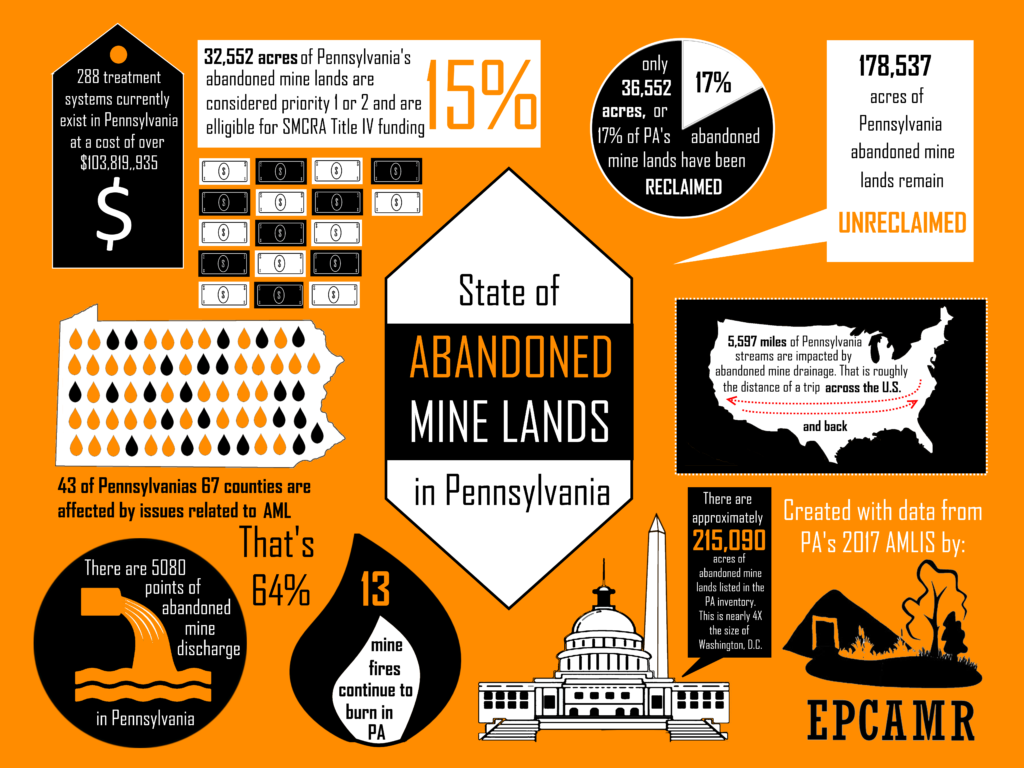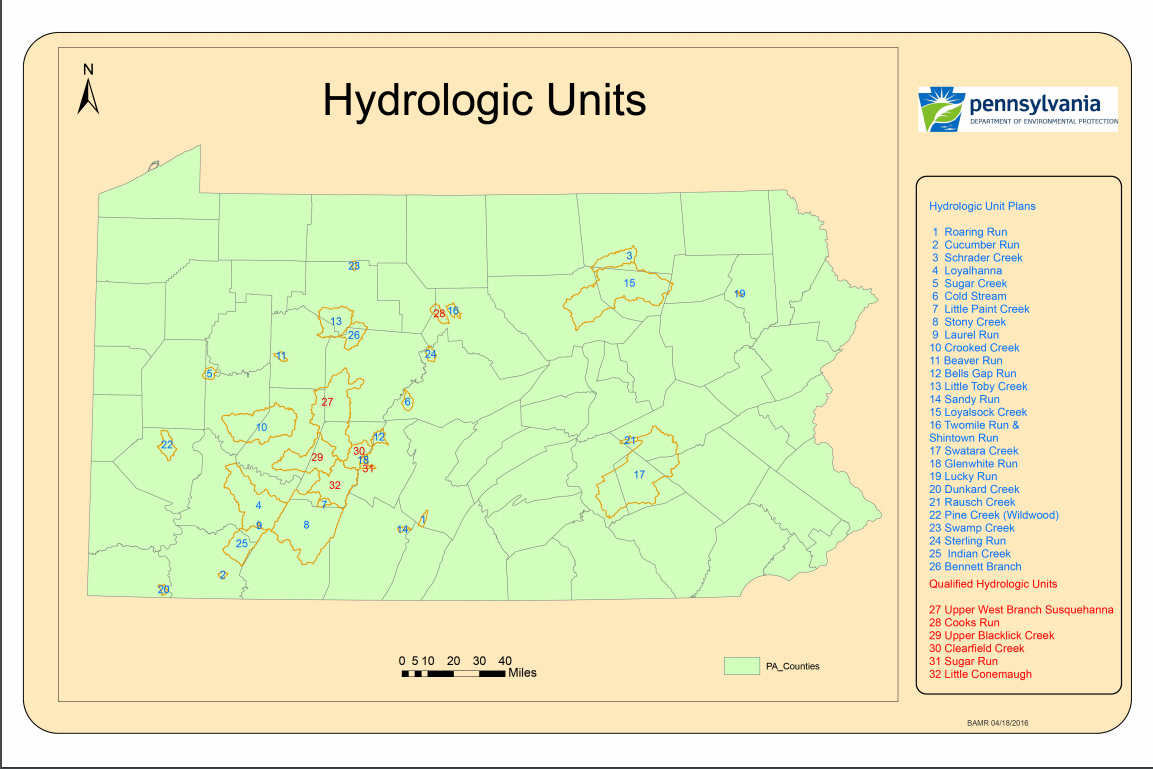One behalf of the Eastern PA Coalition for Abandoned Mine Reclamation (EPCAMR), the EPCAMR Executive Director submitted public comments and our perspective within the coalfields of Northeastern and Northcentral PA, where many of our communities have been historically disenfranchised and to this day still are and don’t have access to many opportunities to participate in direct decisions to make improvements to their local environment, rivers, streams, and abandoned mine lands that were previously impacted by abandoned mines. EPCAMR is a 20+ year regional non-profit organization, located in the heart of the Northern Anthracite Coalfields, in the Borough of Ashley, an environmental justice community, within the Wyoming Valley.
Robert E. Hughes, Executive Director goes on to say, “We work with our underserved communities and school districts to provide environmental education programs, events, community cleanup projects, environmental restoration projects, and land and water remediation efforts to improve the community health and well-being of our region that have been underrepresented, underfunded, and not been prioritized strongly enough on the State level to receive the attention these communities deserve.”

Robert E. Hughes, EPCAMR Executive Director surrounded by 5th grade students from Heights Elementary at a Trout in the Classroom release event and AMD Education Program at Frances Slocum State Park.
EPCAMR agrees that environmental justice does embody the principles that coalfield communities should not be disproportionately exposed to adverse environmental impacts, yet, we continue to live in both urban and rural communities that are surrounded by 5,597 miles of streams and 178,537 acres of abandoned mine lands across PA that are impacted by abandoned mine drainage (AMD) that render our watersheds, rivers, and streams that are affected unable to be utilized for what many communities take for granted, such as fishing, boating, swimming, industrial use, and on the water outdoor recreational uses.
Below are EPCAMR’s Executive Director’s responses to the PA DEP Office of Environmental Justice’s specific questions.
Specific Questions
— What environmental justice concerns are most pressing in your community?
The most pressing environmental justice concerns in our community are non-point source pollution from abandoned mine lands in the form of abandoned mine drainage (AMD), the illegal dumping of household hazardous wastes, tires, trash, and drug paraphernalia on lands and along streams within the coalfield communities. Thousands of miles of streams are impacted and polluted by AMD. Thousands more are impacted by abandoned mine lands. Figure 1. was created by EPCAMR using PA’s 2017 Abandoned Mine Land Inventory System (AMLIS).
Figure 1. State of Abandoned Mine Lands in PA
There is a lack of prioritization of funding under many of the State Programs for these communities. Many of the communities have designations within them under on the stream segments that on the Federal level and State Level which list them as on Federal List of Impaired Waters, making them eligible for funding, however they are not given priority, in many cases under the State’s Growing Greener Grant Program, for example. Many of the stream segments and watersheds throughout NE and NC PA are also not qualified to receive additional Federal funding under the State’s Set Aside Program, funded under the Surface Mining Reclamation Control & Reclamation Act’s Title IV Abandoned Mine Land Trust Fund yearly allocation because they are not designated as Qualified Hydrologic Units, nor do they have Qualified Hydrologic Unit Plans developed.
Figure 2. below shows that only 5 QHU Plans have been officially developed that EPCAMR is aware of and we understand that a few more are underway in some other coalfield impacted watersheds in the Southern Anthracite Coalfields and in the Eastern Middle Anthracite Region. EPCAMR has offered to provide the technical assistance to develop these plans for approval should funding become available to allow our organization to properly assess the watersheds and stream segments to meet the criteria under the Set Aside Program. We have proposed grants to perform such technical tasks in previous grant rounds and were denied funding for the opportunity to assist the State in the much-needed development of these QHUPs. The denial of funding could have been due to limited funds available under the Program.
Figure 2. Hydrologic Unit Plans Approved Across PA (PA DEP, 2009)
Figure 3. shows the 39 locations that are designated Environmental Justice areas within the 16 County EPCAMR Region, where only 15 political municipal sub-divisions have been designated, within 15 unified places, in 11 School Districts. ~ 19,461.50 acres of land affected within this region. These numbers are grossly underreported and EPCAMR believes that many more communities and tracts need to be added and expanded to include additional coalfield communities throughout the EPCAMR Region. There are entire watersheds that are impacted by AMD that are not included in these areas, which means that they are not getting the attention that they deserve. The impacts of AMD and water pollution do not stop at political boundaries and Census Tracts. It may be more suitable to begin looking at increasing areas of Environmental Justice to watershed boundaries that are more clearly defined and then one can review the statistics to see where the concentration of the pollution problems are located.
One will find that in certain watersheds, the headwater areas will be unimpacted, with less dense populations affected, and then as you follow the streams and tributaries down into the Valley cities and municipalities, they areas become more impacted and areas are highly concentrated with larger populations that experience the environmental justice issues. Non-profit organizations like EPCAMR are always looking to secure funding to work with these communities because often times, there are no professionally staffed environmental organizations within these communities to do the research and are trained to perform the necessary assessments, grant writing, technical reporting, and monitoring that is required to secure funds to improve the overall quality and community health of their watersheds.
Our communities also lack large community foundations and access to funds to cleanup our communities.
Figure 3. Acreage, Poverty % Statistics, County Subdivision, and Unified School Districts in the EPCAMR Region (US Census, 2010)
| ACREAGE | POVERTY % | COUNTY SUBDIVISION | UNIFIED SCHOOL DISTRICTS |
| 427.90 | 22.45 | Carbondale city | Carbondale Area School |
| 934.07 | 21.315 | Carbondale city | Carbondale Area School |
| 603.57 | 22.225 | Forest City borough | Forest City Regional School |
| 224.57 | 20.425 | Nanticoke city | Greater Nanticoke Area School |
| 591.60 | 20.595 | Ashley borough | Hanover Area School |
| 1764.27 | 20.98 | Hanover township | Hanover Area School |
| 430.56 | 22.95 | Freeland borough | Hazleton Area School |
| 186.17 | 23.07 | Hazleton City | Hazleton Area School |
| 123.59 | 21.89 | Hazleton City | Hazleton Area School |
| 144.99 | 21.95 | Hazleton City | Hazleton Area School |
| 544.572 | 21.74 | Hazleton city | Hazleton Area School |
| 734.68 | 29.05 | Hazleton city | Hazleton Area School |
| 468.52 | 21.94 | West Hazleton borough | Hazleton Area School |
| 983.66 | 22.43 | Lansford borough | Panther Valley School |
| 360.96 | 27.58 | Pottsville city | Pottsville Area School |
| 611.75 | 24.71 | Pottsville city | Pottsville Area School |
| 175.66 | 58.52 | Scranton city | Scranton School |
| 713.54 | 21.95 | Scranton city | Scranton School |
| 442.79 | 31.80 | Scranton city | Scranton School |
| 395.39 | 31.54 | Scranton city | Scranton School |
| 666.44 | 39.32 | Scranton city | Scranton School |
| 242.65 | 39.29 | Scranton city | Scranton School |
| 1701.51 | 19.56 | Scranton city | Scranton School |
| 127.68 | 26.93 | Scranton city | Scranton School |
| 130.13 | 31.33 | Scranton city | Scranton School |
| 1996.98 | 24.68 | Tamaqua borough | Tamaqua Area School |
| 524.30 | 45.43 | Wilkes-Barre city | Wilkes-Barre Area School |
| 249.17 | 30.22 | Wilkes-Barre city | Wilkes-Barre Area School |
| 245.76 | 35.50 | Wilkes-Barre city | Wilkes-Barre Area School |
| 220.10 | 40.41 | Wilkes-Barre city | Wilkes-Barre Area School |
| 243.88 | 23.94 | Wilkes-Barre city | Wilkes-Barre Area School |
| 148.27 | 33.61 | Wilkes-Barre city | Wilkes-Barre Area School |
| 244.05 | 25.07 | Wilkes-Barre city | Wilkes-Barre Area School |
| 88.99 | 24.03 | Wilkes-Barre city | Wilkes-Barre Area School |
| 247.16 | 24.90 | Wilkes-Barre city | Wilkes-Barre Area School |
| 763.93 | 24.32 | Edwardsville borough | Wyoming Valley West School |
| 266.53 | 42.25 | Plymouth borough | Wyoming Valley West School |
| 232.08 | 21.78 | Plymouth borough | Wyoming Valley West School |
| 259.05 | 20.30 | Plymouth borough | Wyoming Valley West School |
— Do you feel that the current definition of an environmental justice community (20 percent poverty or 30 percent minority, or both) properly represents the needs of your community and the Commonwealth at large?
No. The definition should not define environmental justice solely by the 20% poverty rate or the 30% minority population because minority populations are not the only ones affected by environmental pollution. It should not matter what the percentage is if the pollution problem exists because the polluted lands and water don’t discriminate against population segments or Census defined categories of people based on their minority or ethnic backgrounds.
— Do you feel the Department is engaged with marginalized communities to ensure that they have a voice in the decision-making process? How can the Department be more engaged with these communities?
No. I have not seen the OEJ in our particular region of NE PA. We have many communities that are marginalized in our region and none of the listening sessions are even located in our area. EPCAMR is in an OEJ community and are not aware of any attempts to make the Borough of Ashley or a group such as ours aware of the impacts that certain projects may have on our community. We need to be able to provide easier access to the political process and be sure that our volunteers and members of the communities that we are serving are having their voice heard. We have no Regional Coordinator for the NE Region of PA. The OEJ can make our organization more aware of projects and meetings and then we can let our community groups know about them through our network to encourage more participation and local involvement. Legal ads and public notices are not often seen by the communities that we work in if they are used to notify the public about permits, nor is the Federal Register. EPCAMR is a non-profit that could benefit from the support of industries that are coming into the area that want to have a positive impact on the surrounding communities if they were able to provide donations of services, grants, a volunteer incentive program, or opportunities for partnerships on projects that will improve the environment. Notification should include community centers, electronic notices to regional non-profit groups, and municipalities.
— What tools have you used to find out information on Department permitting/enforcement actions?
e-Facts (http://www.ahs.dep.pa.gov/eFACTSWeb/default.aspx). Review of Surface Mining Permits in the Pottsville or Moshannon District Mining Offices.
— What ways can the Department be more effective at sharing information with the public?
E-mails to the public who sign up to receive notifications of permitting and enforcement actions or new projects.
— How can the Department be more effective at receiving public input?
Provide notification to people who sign up through a website portal through the OEJ to receive additional input and notifications on public information for projects, permitting, or enforcement actions. Flyers should go to community centers and municipal buildings in the EJ areas.
— What resource is your community lacking that the Department can provide that would assist in efforts to ensure environmental equity?
Funding to be able to conduct outreach to the community members of the EJ areas to build capacity within the communities to allow them to have a voice.
— What additional steps can be taken by the Department to effectively reach out to these vulnerable communities to ensure that their concerns are taken into consideration?
Provide a Regional Coordinator for the NE Region.
Below is some information from the PA DEP OEJ Website.
Download the Listening Tour brochure
PROVIDE US WITH YOUR COMMENTS & THOUGHTS BY MAY 25
- In person at one of the EJ listening tour stops
- Online at DEP-OEJ@pa.gov
- In writing at:
Rachel Carson State Ofce Building
Office of Environmental Justice
400 Market Street, 16th Floor
Harrisburg, PA 17101
SESSION SCHEDULE REMAINING
May 11, 2017 5 p.m. – 7 p.m.
Lehigh County
Allentown Public Library
Community Room
1210 Hamilton Street
Allentown, PA 18102
May 15, 2017, 5 p.m. – 7 p.m.
Lancaster County
HACC Lancaster Campus
East Building, Room 203
1641 Old Philadelphia Pike
Lancaster, PA 17602
May 23, 2017, 5 p.m. – 7 p.m.
Delaware County
Chester City Hall Council Chambers
1 Fourth Street,
Chester, PA 19013
May 25, 2017, 4 p.m. – 6 p.m.
Philadelphia County
Fairmount Water Works
640 Water Works Drive
Philadelphia, PA 19130
CONTACT US
Carl Jones, Jr., Esq. Director
caejone@pa.gov, (484) 250-5818
Nora Alwine, Regional Coordinator
nalwine@pa.gov, (412) 442-4137
John Brakeall, Regional Coordinator
jbrakeall@pa.gov, (717) 783-9731
Pennsylvania Department of Environmental Protection
Ofce of Environmental Justice
P.O. Box 7732 Harrisburg, PA 17101
(484) 250-5942














You must be logged in to post a comment.